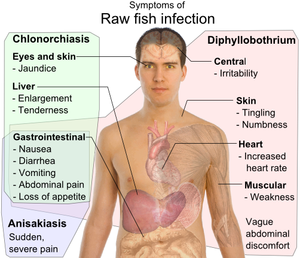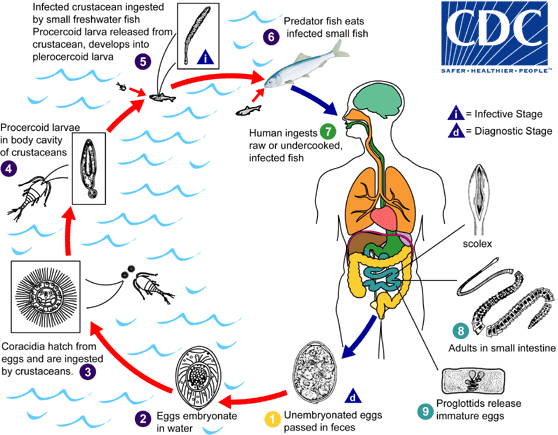Diphyllobothriasis is the infection caused by the tapeworm Diphyllobothrium.
Geographic distribution

Diphyllobothriasis occurs in areas where lakes and rivers coexist with human consumption of raw or undercooked freshwater fish. Such areas are found in Europe, newly independent states of the former Soviet Union, North America, Asia, Uganda, Peru (because of Ceviche), and Chile. It is particularly common in Japan, because of Sushi or Sashimi.
Around the middle of the 20th century in Japan, before advancements in refrigeration, many sushi/sashimi connoisseurs suffered great morbidity and mortality from Diphyllobothrium after eating unrefrigerated sashimi. Through research in parasitology, scientists came to realize that the primary cause was the relatively favorable parasite-breeding conditions that raw fish offered.
The disease is rare in the United States. It was, however, once more common and was referred to as "Jewish housewife's disease" because Jewish housewives preparing the traditional "gefilte fish" frequently tasted the fish before it was cooked.
Clinical features

Diphyllobothriasis can last for decades if untreated. Most infections are asymptomatic. Manifestations may include abdominal discomfort, diarrhea, vomiting and weight loss. Vitamin B12 deficiency with subsequent megaloblastic anemia may occur, but has not for several decades in D. latum infections, possibly because of improved nutrition. In one test, nearly half of the ingested vitamin was absorbed by D. latum in otherwise healthy patients, while 80-100% was absorbed by the worm in patients with anemia. It is not known why anemia occurs in some cases but not others. Massive infections may result in intestinal obstruction. Migration of proglottids can cause cholecystitis or cholangitis.
Females cases are disproportionately reported, most likely due to the higher likelihood for them to be involved in meal preparation, rather than any morphological differences.
Diagnosis
Microscopic identification of eggs in the stool is the basis of specific diagnosis. Eggs are usually numerous and can be demonstrated without concentration techniques. Examination of proglottids passed in the stool is also of diagnostic value.
Diagnostic tool:
- Microscopy
- Morphologic comparison with other intestinal parasites
Though it is difficult to identify the eggs or proglottids to the species level, the distinction is of little medical importance because, like most adult tapeworms in the intestine, all members of this genus respond to the same drugs.
Treatment
Upon diagnosis, treatment is quite simple and effective. The standard treatment for diphyllobothriasis, as well as many other tapeworm infections is a single dose of Praziquantel, 5â€"10 mg/kg PO once for both adults and children. An alternative treatment is Niclosamide, 2 g PO once for adults or 50 mg/kg PO once. One should note that Praziquantel is not FDA approved for this indication and Niclosamide is not available for human use in the United States. Another interesting potential diagnostic tool and treatment is the contrast medium, Gastrografin, introduced into the duodenum, which allows both visualization of the parasite, and has also been shown to cause detachment and passing of the whole worm.
Prevention
Avoid ingestion of raw freshwater fish. Adequate cooking or freezing of freshwater fish will kill the encysted fish tapeworm larvae. Also, because human feces is an important mechanism for spreading eggs, proper disposal of sewage can cut down on infection of fish and thus of humans.
References
External links
- "DPDx - Diphyllobothriasis". CDC Division of Parasitic Diseases.Â
